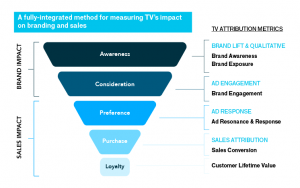 Attribution has been, and will continue to be, a hot topic for those in the Marketing world – and for good reason. Beyond measuring TV’s impact on Sales outcomes, attribution can also be used to gain deeper insight into the performance of specific campaign variables such as message, creative, target audience, media schedule, ad placement, format and length, among others.
Attribution has been, and will continue to be, a hot topic for those in the Marketing world – and for good reason. Beyond measuring TV’s impact on Sales outcomes, attribution can also be used to gain deeper insight into the performance of specific campaign variables such as message, creative, target audience, media schedule, ad placement, format and length, among others.
With pressure building for brands to get the best possible Return On Investment (ROI) from their ad spend, attribution is at the heart of mounting efforts to leverage data, evaluate creative performance across separate media channels and quantify how much of a company’s Marketing mix contributes to Brand Building and Sales.
Attribution is versatile and can be defined in many ways, so it’s worth focusing on one form of attribution that has been critically overlooked by those that stand the most to gain from utilizing it…
Full-funnel TV attribution
Full-funnel attribution measures the impact of TV advertising on both Branding and Sales – also known as the top and bottom of the Marketing funnel, respectively. At the top of the Marketing funnel, brand awareness and reputation is built. Sales occur at the bottom of the funnel, which has been a keen area of focus for marketers looking to demonstrate a strong ROI from their ad spend.
True ROI goes beyond bottom-line Sales, and a real understanding of the upper funnel impact of TV is essential. A full-funnel approach measures the entire spectrum of brand awareness, perception and favorability, in addition to mid and lower funnel metrics including ad engagement, ad response and Sales conversion.
If marketers focus on measuring Sales attribution alone, they’re only accounting for a portion of the value that television delivers. While Sales outcomes may be the ultimate goal of a campaign, unless marketers understand TV’s impact on brand awareness perception and favorability they may be missing some of the key insights needed to drive consumer demand and customer acquisition. In other words, driving new customers into the funnel is just as important as converting customers within the funnel. Full-funnel TV attribution can accomplish both.
Gathering insights
Unlike attribution models derived from small samples, a full-funnel attribution method requires larger, more census-based data. In doing so, marketers can also leverage data they trust – such as first-party CRM data – to understand a campaign’s effects on Consumer Behavior, Favorability and Sales. Marketers can also make use of industry data partners with analytics and optimization tools at their disposal, who can provide an expanded dataset and source Sales attribution and conversion metrics (including transactional, mobile location and digital data).
 Once the data is available, marketers can use attribution to glean countless insights from their campaign. For instance, they can identify target audiences most responsive to TV, determine which creative or ad format performed best (and worst) at driving brand favorability – and uncover insights regarding which aspect of the campaign had the most (and least) significant Brand or Sales impact.
Once the data is available, marketers can use attribution to glean countless insights from their campaign. For instance, they can identify target audiences most responsive to TV, determine which creative or ad format performed best (and worst) at driving brand favorability – and uncover insights regarding which aspect of the campaign had the most (and least) significant Brand or Sales impact.
Turning insights into action
These takeaways can provide tremendous value to advertisers, and the key is determining how best to put these new insights into action to improve the campaign, reach the right audiences and maximize ROI. To conduct a successful TV attribution project, advertisers should:
1. Have a specific goal or goals in mind. With so many insights available through attribution, marketers should zero in on what is most important for their campaign (i.e. driving sales, brand lift, or the intersection of both).
2. Pick your data sources wisely. They must be broad enough to ensure stable, representative findings while also granular enough to allow for deep dives into any aspect of the campaign.
3. Ensure that a proper test/control methodology is utilized vs. a more naïve ‘exposed’, ‘non-exposed’ method. This will help ensure that any insights gleaned are stable enough to consult during future campaigns, rather than starting from square one each time.
4. Study TV attribution over time. By measuring TV attribution on an ongoing basis, marketers can maximize their TV ad investment, optimize their campaigns in real-time by gleaning and incorporating continuous insights, and learning to account for seasonal trends, promotions and cyclical viewership habits.
Read more: Looking Ahead: Predictions for Programmatic Advanced TV Advertising












Comments are closed.